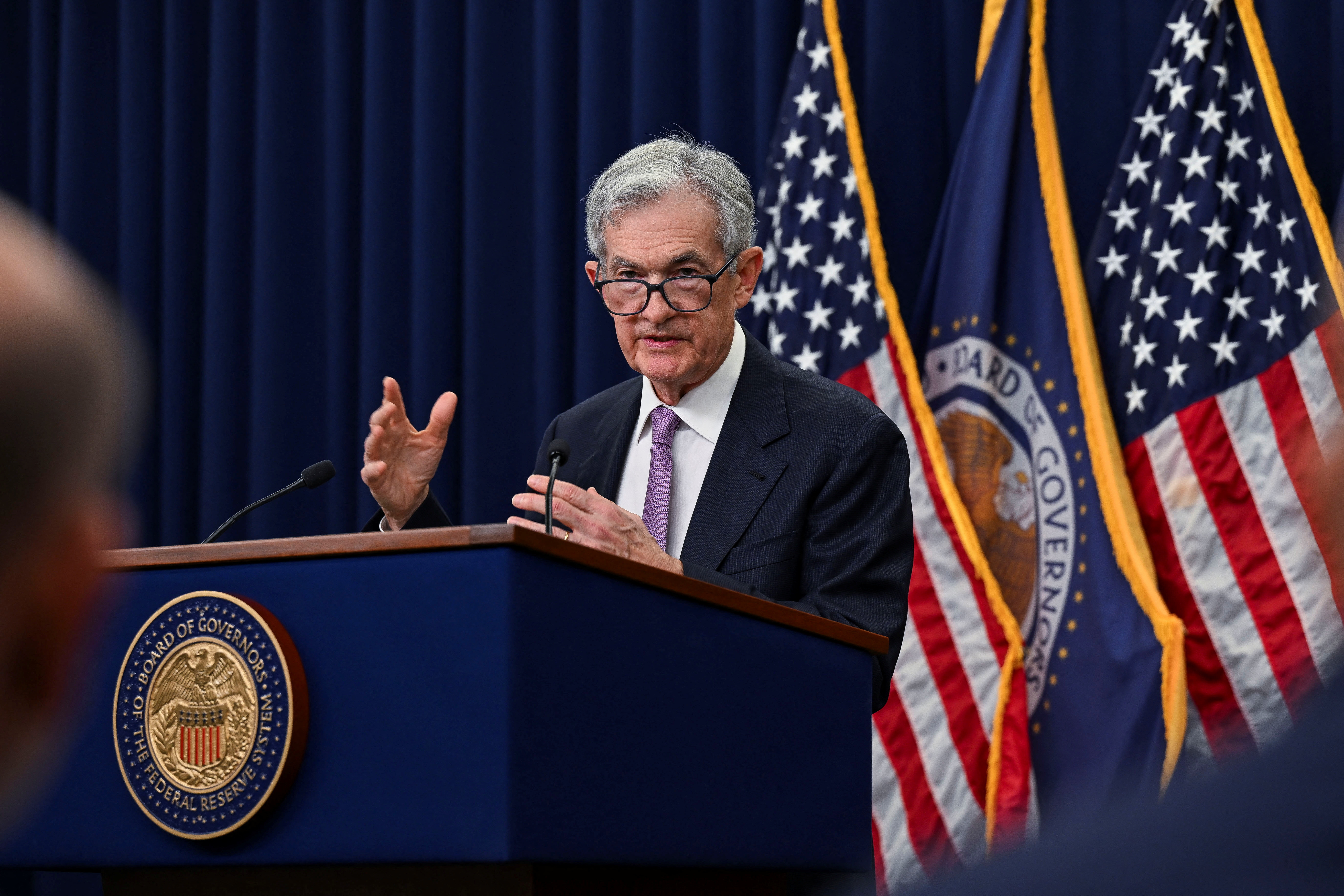
Trump Demands Fed Governor Resign and Blasts Powell Over Mortgage Rates in Truth Social Attack
The Independence Premium: How Trump's Fed Pressure Campaign Reshapes Market Dynamics
WASHINGTON — Today President Donald Trump escalated his confrontation with Federal Reserve leadership through a series of Truth Social posts that marked a new intensity in executive pressure on monetary policy. "Cook must resign, now!!!" Trump declared, targeting Federal Reserve Governor Lisa Cook. In a subsequent post, he attacked Fed Chair Jerome Powell directly: "Could somebody please inform Jerome 'Too Late' Powell that he is hurting the Housing Industry, very badly? People can't get a Mortgage because of him. There is no Inflation, and every sign is pointing to a major Rate Cut."

These public demands came against a backdrop of coordinated administrative pressure that extends well beyond social media rhetoric. The Trump administration has systematically positioned allies in key regulatory positions while pursuing legal avenues to challenge Fed personnel—creating what market analysts increasingly view as an unprecedented test of central bank independence.
The proximate trigger for Trump's attack on Cook stems from Federal Housing Finance Agency Director Bill Pulte's formal referral to Attorney General Pam Bondi regarding alleged mortgage disclosure irregularities involving Cook's 2021 property transactions. Pulte, a Trump ally confirmed to lead the housing regulator in March 2025, has accused Cook of violating primary residence requirements in mortgage applications. While no criminal charges have been filed, the referral has provided the administration with a legal justification for demanding Cook's resignation.
This pressure campaign arrives at a critical juncture, with the Federal Reserve's next policy meeting scheduled for September 16-17 and Chair Powell set to deliver closely watched remarks at the Jackson Hole Economic Symposium. The timing suggests a coordinated effort to influence monetary policy decisions through public pressure, legal intimidation, and strategic personnel moves.
The Choreographed Assault on Fed Independence
Market professionals increasingly view recent developments through the lens of "fiscal dominance"—the economic theory that heavily indebted governments eventually subordinate monetary policy to their borrowing needs. With federal deficits swelling and Treasury issuance accelerating, the administration faces mounting pressure to reduce funding costs through artificially suppressed interest rates.
Did you know that fiscal dominance occurs when a government’s pressure to finance its deficits and high debt levels forces the central bank to prioritize supporting fiscal needs—often by keeping interest rates low or purchasing government debt—over controlling inflation? This phenomenon can undermine the central bank’s independence and lead to higher inflation, as monetary policy becomes a tool for deficit financing rather than price stability, with historical examples including episodes of high inflation and even hyperinflation in countries like Argentina and Zimbabwe.
"What we're witnessing represents a fundamental stress test of institutional independence," noted one senior fixed-income strategist who requested anonymity due to the sensitivity of criticizing administration policy. "The coordinated nature—legal pressure on Cook, the Miran nomination fast-track, Bessent's public rate-cut advocacy—suggests this goes well beyond improvised political theater."
Table: U.S. Federal Debt Held by the Public as a Percentage of GDP – Recent Trends and Projections
| Time Period/Year | Debt as % of GDP | Notes |
|---|---|---|
| Late 1970s – Early 1980s | ~30-32% | Lowest debt-to-GDP ratio in recent decades |
| 1980s – Early 1990s | Rising steadily | Growth linked to Reagan-Bush era federal deficits |
| 2008 (Financial Crisis) | Sharp increase | Debt ratio increased due to Great Recession measures |
| Q2 2020 (Pandemic Peak) | ~133% | Historic spike due to COVID-19 relief and economic impact |
| End of 2024 | ~97% | Latest reported federal debt held by public ratio |
| End of 2024 (total gov.) | ~124% | Includes intragovernmental holdings |
| CBO Projection 2034 | 116% | Projected continued rise |
| CBO Projection 2054 | 172% | Long-term projection if current trends continue |
The timing proves particularly strategic. With Fed Chair Jerome Powell's term expiring in May 2026, the administration has accelerated vetting of potential successors while simultaneously pressuring current Board composition. The recent resignation of Governor Adriana Kugler created a vacancy now filled by Stephen Miran, whose confirmation would tilt the Board toward more accommodative policy.
Treasury Secretary Scott Bessent's public endorsement of a 50-basis-point September cut—double market expectations—signals coordinated messaging designed to shift the Overton window of acceptable policy discourse.
The Inflation Mirage and Housing Reality
Trump's assertion that "there is no Inflation" directly contradicts July's consumer price data showing 2.7% year-over-year headline inflation and 3.1% core inflation—both substantially above the Fed's 2% target. This deliberate mischaracterization serves to narrow policy debate toward housing pain while sidestepping tariff-driven price pressures that Fed officials have repeatedly highlighted.
Did you know that as of mid-2025, the U.S. Consumer Price Index (CPI) inflation rate stands at about 2.7% year-over-year, while the Core CPI inflation rate, which excludes volatile food and energy prices, is around 3.1%? Both figures remain above the Federal Reserve’s long-term target of 2% inflation, indicating that despite some moderation, inflation pressures persist in the economy. The Federal Reserve closely monitors these inflation measures to guide its monetary policy decisions aiming to maintain stable prices and support economic growth.
The housing narrative, while politically potent, obscures complex market dynamics. Mortgage rates currently averaging 6.58% reflect not just policy rates but also Treasury term premiums and mortgage-backed securities spreads that respond to broader market confidence in institutional stability.

"The fundamental disconnect between political rhetoric and market mechanics creates dangerous feedback loops," explained a mortgage market specialist. "Threats to Fed independence can actually raise long-term borrowing costs even as short-term rates fall, potentially making housing affordability worse."
Recent data support this counterintuitive dynamic. Despite modestly improved mortgage availability according to the Mortgage Bankers Association's July index, credit remains constrained by supply shortages, elevated home prices, and builder sentiment that has deteriorated even as some purchase incentives increase.
Market Implications: Pricing the Independence Premium
Professional investors are rapidly recalibrating risk models to account for what strategists term the "independence premium"—additional compensation demanded for holding assets subject to political capture risk. This repricing manifests across multiple asset classes but proves particularly acute in interest rate markets.
Forward curve dynamics suggest markets expect modest accommodation—likely 25 basis points in September—but with elevated term premiums reflecting uncertainty about the Fed's reaction function under sustained political pressure. The result creates what one derivatives trader characterized as "asymmetric volatility skew favoring steepening scenarios."
Did you know that the bond term premium is the extra return investors demand for holding longer-term bonds instead of shorter-term ones? This premium compensates for the added risks such as interest rate changes and inflation uncertainty that can affect bond prices over time. It explains why longer-term bonds usually offer higher yields and plays a key role in shaping the yield curve, influencing investment choices and monetary policy decisions. Although the term premium isn't directly observable, experts estimate it by comparing long-term bond yields with expected future short-term rates. Understanding this helps reveal the hidden costs and rewards of investing in bonds with different maturities.
Currency markets exhibit similar caution. The dollar's recent softening against major crosses reflects not just dovish Fed expectations but growing concerns about institutional credibility that could undermine the greenback's safe-haven premium over time.
Banking sector performance reveals additional complexity. While a steeper yield curve theoretically benefits net interest margins, available-for-sale securities portfolios remain vulnerable to duration risk if term premiums expand unexpectedly. Regional banks with shorter asset duration profiles and robust deposit franchises appear better positioned for the volatility ahead.
The Jackson Hole Inflection Point
Powell's Friday address at the Federal Reserve's annual Jackson Hole symposium will provide the first major test of institutional resolve under direct political pressure. Market participants will parse every syllable for signals about the Fed's willingness to resist political capture while managing legitimate economic concerns.

Historical precedent offers limited guidance. While central banks worldwide have weathered political pressure campaigns, the combination of fiscal stress, institutional polarization, and social media amplification creates unprecedented dynamics for Fed independence.
"We're in uncharted territory regarding the interaction between political pressure and market confidence," observed a senior portfolio manager overseeing multi-billion-dollar fixed-income strategies. "The September FOMC represents a potential inflection point that could reshape monetary policy credibility for years."
Investment Positioning for Institutional Uncertainty
Sophisticated institutional strategies increasingly focus on hedging political risk rather than traditional economic fundamentals. Yield curve positioning favors steepening trades that benefit from independence premium expansion while maintaining optionality around Fed policy pivots.
Did you know that the yield curve is a crucial financial tool that plots the interest rates of bonds with the same credit quality but different maturities? Its shape—whether normal, inverted, or flat—reveals market expectations about economic growth, inflation, and future interest rates, with an upward slope indicating growth, an inverted slope signaling potential recession, and a flat curve suggesting economic uncertainty. Investors and policymakers closely watch the yield curve for signals about the economy’s future direction. This simple graph offers powerful insights into complex economic trends.
Breakeven inflation markets offer particularly attractive risk-adjusted opportunities. Political pressure toward easier monetary policy, combined with latent tariff-driven price risks, suggests inflation expectations may prove sticky despite near-term disinflationary pressures.
Within credit markets, mortgage-backed securities present nuanced opportunities. Specified pool strategies and mortgage servicing rights provide exposure to housing recovery themes while avoiding negative convexity risks associated with traditional agency mortgage products during volatile rate environments.
Equity sector rotation increasingly reflects the new paradigm. Homebuilders face headwinds from elevated rates despite political pressure for accommodation, while asset-sensitive financial institutions benefit from steeper curves offset by duration risk in securities portfolios.
The Precedent at Stake
Beyond immediate market implications, the current confrontation establishes precedents that will echo through future administrations. Legal scholars note that while Fed governors enjoy protection from removal except "for cause," the boundaries of that protection remain untested in an era of heightened political polarization.
International observers watch with particular attention, recognizing that perceived Fed capture could undermine dollar dominance and complicate global financial stability. Central bank independence represents a cornerstone of modern monetary frameworks, making the current stress test globally consequential.

Market participants increasingly price scenarios where political pressure succeeds in extracting deeper cuts while simultaneously raising long-term borrowing costs through reduced institutional credibility—a paradoxical outcome that could worsen rather than improve housing affordability.
The stakes extend beyond immediate policy outcomes toward fundamental questions about institutional resilience in democratic systems under fiscal stress. September's FOMC meeting will reveal whether economic institutions can maintain credibility while managing political pressure—or whether markets must permanently price a new era of monetary-fiscal coordination.
This analysis is based on current market data and established economic indicators. Past performance does not guarantee future results. Readers should consult qualified financial advisors for personalized investment guidance.